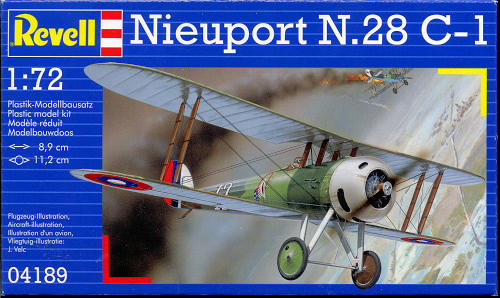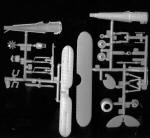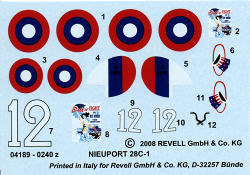
Revell 1/72 Nieuport 28C-1
| KIT: | Revell 1/72 Nieuport 28C-1 |
| KIT #: | 04189 |
| PRICE: | $6.75 MSRP |
| DECALS: | One option |
| REVIEWER: | Scott Van Aken |
| NOTES: | Reissue |

| HISTORY |
The first aircraft to be flown by the nascent USAS was the Nieuport 28. This was a sleek looking aircraft that, due to its relatively poor quality of construction, tended to shed the fabric on the upper wing if flung about the sky with too much enthusiasm. This was not good.
Actually, the French preferred the newer and more capable SPAD, so naturally, in a move to keep Frenchmen employed at the Nieuport factory, the French took delivery of nearly 300 of these planes and foisted them off on the unsuspecting Americans at the earliest opportunity. The Americans wanted the SPAD as well, but none were available for their use so they had to make do with the Nieuport. Despite the hazards of flying the Nieuport 28, the 1st Pursuit Group was able to use the nimble aircraft to its best advantage. In a matter of months, several Americans had become aces, all flying the Nieuport 28. Though it was not with any sadness that the plane was eventually replaced by the SPAD near the end of the war, the Nieuport fighter was instrumental in the success and training of the first generation of US fighter aces.
| THE KIT |
 This little gem is no stranger to many of us. I can recall building a number of these (all without rigging, of course), back in my earlier days. At that time, Revell had brought out this kit with a 'frameable' picture box top, though most of us ignored that and got right down to painting and gluing. This was the 60's and in many ways, the hey-day of plastic modeling. At least in numbers and availability. The kit was later reissued when Revell started providing multiple markings options for its small scale kits.
This little gem is no stranger to many of us. I can recall building a number of these (all without rigging, of course), back in my earlier days. At that time, Revell had brought out this kit with a 'frameable' picture box top, though most of us ignored that and got right down to painting and gluing. This was the 60's and in many ways, the hey-day of plastic modeling. At least in numbers and availability. The kit was later reissued when Revell started providing multiple markings options for its small scale kits.
Fast forward to the 21st Century and the kit is still around. Looking pretty good, if you ask me. Sure, there is some flash, but not much. Sure, there are major ejector pin marks on the underside of the one piece flying surfaces, but nothing a bit of sand paper won't cure. Sure, there is no cockpit and a poor pilot whose legs have been amputated at the knees, but he does fill an otherwise gaping hole and he does have a proper seat (of sorts). There is a fairly nicely done rotary engine and once the prop is attached, it will spin. Biggest thing one may wish to alter is the shape of the cowling. The forward section is really too square and should be much more rounded than is kitted, but you can pretend that Trumpeter did the molds! There is even a thick windscreen frame, though no clear bit to go in it.
Revell AG has its usual overkill of instructions with warnings about not mixing modeling and alcohol, and encouraging you not to eat the parts in 75 or so languages. There is the usual 'Revell only' paint list that will have you mixing paints for some of the colors that other companies make ready to go. Pictograms galore for the build with many diagrams and a nice one for rigging as well. The Italian-printed decal sheet is very nice and provides markings for a single aircraft, that one flown by a 1st Lt Edward V Rickenbacker of the 94th Aero Squadron. As all the colors are pretty much hard edged, one could hand paint the entire model, though getting the linen underside without streaks would be a challenge.
| CONCLUSIONS |
There you have it. An old friend reissued at what is many times its initial retail price (which I think was 49 cents), but which is pretty much a good deal at today's prices. Sure, it isn't the most detailed kit in the world, but it isn't bad and even if one wasn't being nostalgic about it, one can make this into a very nice model.
I saw it, bought it and thought I'd share it with you.
July 2008
If you would like your product reviewed fairly and fairly quickly, please contact the editor or see other details in the